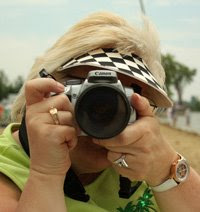 When you're creating your coat of arms, there are several things you should take into consideration. Think about these things while you're putting your coat of arms together and you'll save yourself some frustration later on.
When you're creating your coat of arms, there are several things you should take into consideration. Think about these things while you're putting your coat of arms together and you'll save yourself some frustration later on.
The number one rule in creating a coat of arms is, Don't Overdo. Don't put in too many colors, don't put in too many symbols, don't make it too elaborate... save that for the Queen/Kings of England. When it comes to a coat of arms, simple images work the best in most cases. The thing you want to keep in mind is, how/where are you going to use your coat of arms?
If you're planning on using your coat of arms on commercially printed pieces (which we'll get into in an upcoming post), you want to make sure your design will look good at a variety of different sizes. It's best to create the image large to begin with (8"x10" at 300 dpi is a good size) because it's always easier to resize smaller than it is to resize larger in the print industry. Having said that, unless you've chosen your symbols carefully you may be disappointed with the way they look when resized to fit on a business card. Very detailed images will lose some detail when sized down and may even become unrecognizable. So be careful with the symbols you choose.
Traditional 4-color printing is pricey so you may want to think about creating a coat of arms that would print well in one or two colors. Along this same line, think about the possibility of faxed documents. I know people tend to send more email now than faxes but if you're someone who still prefers to fax documents and you think you might want to use your coat of arms on those documents then you need to make sure your coat of arms will look good in one color. That's when the issue of detail becomes more important. If in viewing an image, you don't have different colors to help discriminate patterns and forms your eyes will naturally rely more heavily on the detail of the form to determine what it is.
Another thing you should keep in mind when creating your coat of arms is to create it in layers and save it that way. Initially, it's best to create your design in flat color. You can add drop shadows, textures, and special effects later if you so desire. This will give you the most options later on when it comes to using your coat of arms.
A last note to keep in mind when creating your coat of arms... be careful not to infringe on someone's copyrighted image. Companies pay a great deal of money for a well designed logo and they don't appreciate you helping yourself to it to use as you will. It may be tempting to incorporate the Ford Motor Company Blue Oval logo in your design if you or your family have a long work history with the company or you always buy Ford cars, but don't do it. You may decide that somewhere down the line you want to sell items with your coat of arms on it and Ford wouldn't take kindly to you making a profit using their logo. Better to be original and creative than a copy cat.
The example above is one of many coat of arms I've designed. The shield is divided into 4 sections with the largest having a fox in it. The root of the name Lisowski is "Lis" and in Polish that means "fox". The other three sections each have a different eagle representing the three countries my Lisowski family members reside in. One is the Polish eagle, one is the American eagle, and the third is the eagle of Germany. While the image of the fox is quite simple, the eagles have a lot of detail to them. This coat of arms was designed originally at 8"x10" size and scaled down to roughly 3"x2" size quite nicely for this Christmas ornament. However, I'm not sure it would reduce well to a size small enough to put on a business card. Fortunately, that's not an issue for me since I have no plans to put this coat of arms on a business card :-)
Coming up next: Using Clipart to Create a Coat of Arms
Other posts on this topic:
Why You Need to Design a Coat of Arms for Your Family
Dissecting A Coat of Arms Achievement
Create a Coat of Arms: Design Ideas
Tuesday, June 19, 2007
Create a Coat of Arms: Design Considerations
Posted by
Jasia
at
7:47 AM
![]()
Labels: Coat of Arms
Subscribe to:
Post Comments (Atom)




No comments:
Post a Comment